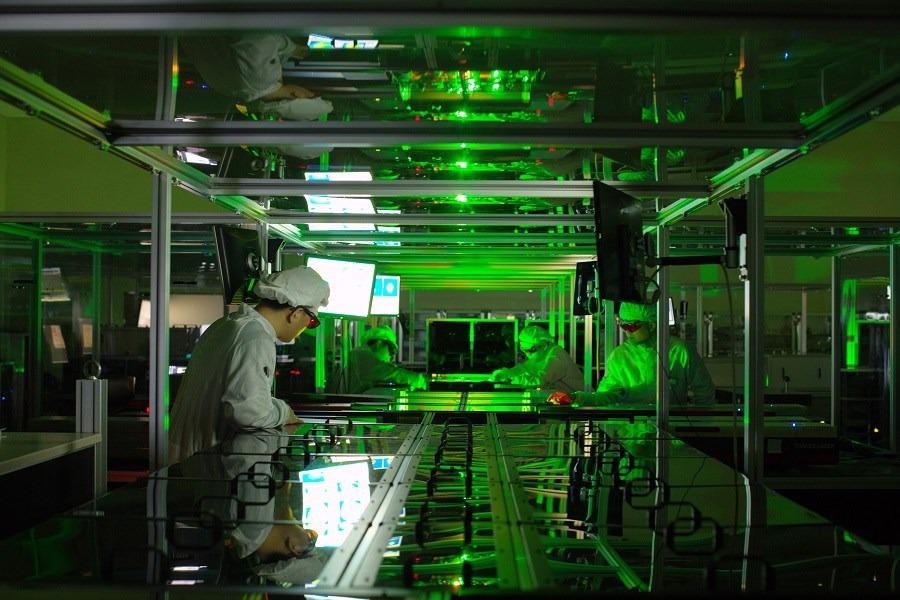May 7 2021
Using a petawatt laser, scientists have demonstrated the highest laser pulse intensity of more than 1023 W/cm2. This laser intensity—which is 10 times more than the one reported by a research team from the University of Michigan in 2004—took more than 10 years to reach this record-high intensity.
 Researchers created high-intensity pulses using the petawatt laser (pictured) at the Center for Relativistic Laser Science (CoReLS) in the Republic of Korea. This high-intensity laser will allow scientists to examine astrophysical phenomena such as electron-photon and photon-photon scattering in the lab. Image Credit: Chang Hee Nam, CoReLS.
Researchers created high-intensity pulses using the petawatt laser (pictured) at the Center for Relativistic Laser Science (CoReLS) in the Republic of Korea. This high-intensity laser will allow scientists to examine astrophysical phenomena such as electron-photon and photon-photon scattering in the lab. Image Credit: Chang Hee Nam, CoReLS.
The petawatt laser is installed at the Center for Relativistic Laser Science (CoReLS), Institute for Basic Science in the Republic of Korea. Such ultra-high intensity light pulses will allow investigators to explore complex interactions between matter and light in ways that were not viable before.
Scientists can also use this strong laser to investigate phenomena that are assumed to be accountable for high-power cosmic rays, the energies of which are over a quadrillion (1015) electronvolts (eV). While investigators are already aware that these cosmic rays emerge from somewhere beyond the solar system, they do not know how they are created and the mechanisms behind their formation.
This high intensity laser will allow us to examine astrophysical phenomena such as electron-photon and photon-photon scattering in the lab. We can use it to experimentally test and access theoretical ideas, some of which were first proposed almost a century ago.
Chang Hee Nam, Director, Center for Relativistic Laser Science, Institute for Basic Science
Nam is also a professor at Gwangju Institute of Science & Technology.
The team has reported their study results in Optica, The Optical Society’s (OSA) journal for high-impact research, describing their years of work to boost the intensity of laser pulses from the CoReLS laser.
A tightly focused laser beam is required to study the laser-matter interactions, but the team was able to direct the laser pulses to a spot measuring just over 1 µm, which is less than 1/50th the diameter of a single strand of human hair. The novel record-breaking laser intensity is similar to directing all the light that reaches the earth from the sun to a spot measuring just 10 µm in size.
This high-intensity laser will let us tackle new and challenging science, especially strong field quantum electrodynamics, which has been mainly dealt with by theoreticians. In addition to helping us better understand astrophysical phenomena, it could also provide the information necessary to develop new sources for a type of radiation treatment that uses high-energy protons to treat cancer.
Chang Hee Nam, Director, Center for Relativistic Laser Science, Institute for Basic Science
Making Pulses More Intense
The latest breakthrough extends previous studies where the team had demonstrated a Ti:Sapphire-based femtosecond laser system that generates 4 petawatt (PW) pulses with less than 20 fs durations while remaining focused to a spot of 1 µm.
Reported back in 2017, this laser generated a power that was around 1000 times more than all the electrical power available on earth in a laser pulse that lasts only 20 quadrillionths of a second.
To create high-intensity laser pulses on a certain target, the generated optical pulses should be focused very tightly. In the latest study, the team used an adaptive optics system to accurately offset the optical distortions.
Using deformable mirrors—which have a controllable reflective surface shape—the adaptive optics system accurately rectifies laser distortions and produces a beam with an extremely well-controlled wavefront. The researchers subsequently used a huge off-axis parabolic mirror to obtain a highly tight focus. In this process, the focusing optical system should be handled carefully.
Our years of experience gained while developing ultrahigh power lasers allowed us to accomplish the formidable task of focusing the PW laser with the beam size of 28 cm to a micrometer spot to accomplish a laser intensity exceeding 1023 W/cm2.
Chang Hee Nam, Director, Center for Relativistic Laser Science, Institute for Basic Science
Studying High-Energy Processes
These high-intensity pulses are being used by the researchers to create electrons with an energy of more than 1 GeV (109 eV) and to operate in the nonlinear regime where a single electron strikes many hundred laser photons at the same time.
This process is a kind of robust field quantum electrodynamics, known as nonlinear Compton scattering, which is believed to play a key role in the creation of highly energetic cosmic rays.
The researchers will also apply the radiation pressure produced by the ultra-high intensity laser to speed up protons. Interpreting how this process takes place could help design a novel laser-based proton source for cancer therapies.
Sources that are employed in present-day radiation treatments are produced using an accelerator that needs a large radiation shield. It is believed that a laser-driven proton source will reduce the cost of the system, making the proton oncology machine more affordable and thus more extensively available to patients.
The team is continuing to devise new strategies to improve the intensity of the laser even more without considerably raising the size of the laser system. This could be achieved by figuring out a new way to decrease the duration of the laser pulse.
Today, lasers with peaks power spanning between 1 and 10 PW are being operated and many facilities reaching 100 PW are also being planned. These trends indicate that high-intensity physics will undoubtedly advance tremendously in the days to come.
Journal Reference:
Yoon, J. W., et al. (2021) Realization of laser intensity over 1023 W/cm2. Optica. doi.org/10.1364/OPTICA.420520.